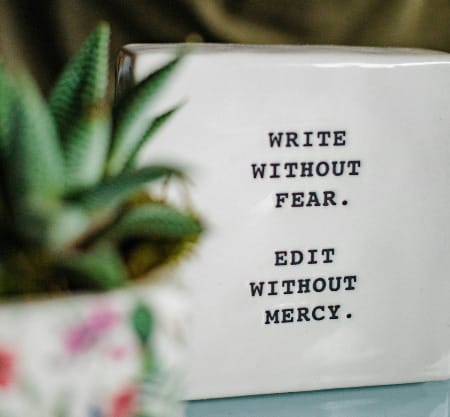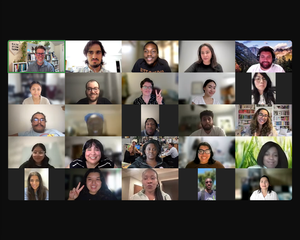Most people think of writing as a solitary activity undertaken by lone geniuses operating under various degrees of inspiration and sheer tenacity.
But business writing is not usually the expression of a single individual's talent — it is generally, and often by definition, the expression of an organization's collective intention. And with real-time, collaborative, online editing platforms like Google Docs, collaborative writing has taken on an even more interactive dimension. It's now possible for you to be working on a document at the same time as others, adding text, leaving comments, and changing words — while other people's variously colored cursors dance through the page doing their own things.
Collaborative writing unlocks powerful new possibilities and enables organizations to create copy that benefits from the talents and knowledge of a whole team of people.
It can also be infuriating, confusing, discouraging, and waste much of everyone's time. It can produce flat, bland, safe, bureaucratic copy, and reads like it was written by a committee — because it was.
How do we make this work better? How do we maximize the benefit of working together while minimizing the process's frustrating and counterproductive parts?
Over and over again, I’ve found that organizing content creation into stages is the key. It creates a process your team can follow. Perhaps even more importantly, it provides language for discussing what’s needed, requesting help, diagnosing what went wrong, and coming up with solutions.
Introducing the POWERS process
After some recent brainstorming, I developed a hopefully not-too-dorky acronym to make these stages more memorable: POWERS.
- Prepare
- Organize
- Write
- Edit
- Release
- Study the results
I’ve used some variation of this approach, albeit without the acronym, in the last several roles I’ve been in. It helps clarify what the team needs to do at each stage and how each content team member (or its clients) can best contribute.
Only the middle step, the actual writing, is an individual exercise. Everything else in this process involves multiple people, in principle, if not in fact. However, if you divide up the writing of a large project into smaller pieces and assign a different part to each writer, then it's also possible for the writing stage to be team-oriented.
Here’s a quick overview of the POWERS process:
Prepare: At this stage, the team is generating ideas, establishing goals, and determining the criteria for success. This stage may also involve research: collecting materials (whether primary sources or secondary, web resources) that can be useful in various stages of creating the work.
The output of this stage is an assignment brief that describes the work and the expected deliverable, which the team can use to generate alignment or gather feedback from other stakeholders.
Organize: Once the team has settled on a topic and has created an abstract or assignment brief approved by all key stakeholders, the next step is to create a detailed outline of what the piece will contain. Many teams will skip this stage or skimp on it — but that's a mistake. The more explicit your plan is about what the final piece should contain, the more valuable it will be in maintaining alignment. In principle, this will also help reduce the time spent on rewrites.
The output of this stage is usually an outline with enough detail that the team can use for another alignment/feedback check, which they can deliver to a writer along with the assignment brief.
Write: Perhaps better called "typing," this stage involves fleshing out the outline to create a first draft. Because the team has already created an assignment brief and detailed outline, it should be clear what the writer's job is: Start at the top and "write through" the outline section by section (for this reason, this could also be called a "write thru," borrowing a term from the journalism world, although the word means something slightly different to journalists). In practice, it can be helpful to break this into sub-stages: Write through the middle sections first, then write the introduction and conclusion.
Even with a well-planned outline, lowering your expectations for the first draft and assuming it will be sloppy can be helpful. This makes getting words on the page easier because it puts your inner critic on hold. Then, after writing through the entire outline, you can put it aside for an hour or two, or a day, then return to the piece and create a cleaner revision.
I can’t emphasize this enough: Separating the writing and the editing is the most effective change you can make to your writing process, whether you’re a solo writer or part of a team. Put your editor aside and just write. Save the perfection for later.
The output of this stage is a first draft: The written piece, more or less complete and ready for editing and review.
Edit: At this stage, the team (or some subset of it) provides feedback and makes changes to the draft. Editing can happen at several levels: structural, flow, line, and proofreading. The structural edit, which focuses on the overall structure of the piece, shouldn't be needed if the outline was well-crafted, but in reality, it may be necessary if the team's goals have shifted or their assessment of the structure has changed. A flow edit focuses on ensuring a good narrative and effective transitions. In contrast, a line edit is a closer edit focused on the paragraph and sentence level, ensuring that the copy is well-written, consistent, accurate, and conforms to the assignment. Finally, copyediting or proofreading is focused on the most detailed levels: grammar, spelling, punctuation, and so forth.

The editing stage can happen in multiple iterations, with editors providing feedback to which the writer responds with a revision, after which the process repeats. It can also occur continuously, with an unbroken stream of comments, updates, and responses between various stakeholders. Regardless of the approach, it's beneficial to have someone in charge of the process (a lead editor) who can decide which edits to approve (if multiple edits conflict) and who is empowered to decide that the copy is final.
The output of this stage is a publication-ready draft.
Release: Like any other product, once a content product is ready, you need to release it. This is the publication stage, when you publish the draft on a blog or social media site or deliver it to the editor of a publication. It's helpful to include promotion and distribution in this stage: Once an article or blog post has been published, it's a mistake to think that readers will simply flock to it. As with any product release, you need a promotion and marketing plan to ensure it connects with the right users (in this case, readers). Releasing a content product also needs to include promoting it through social media, email newsletters, internal employee communications, and so on.
The output of this stage is a published piece of content — and an audience that’s spending time with it.
Study: Once something has been published and promoted, studying the results can really pay off. How many people read it? How much engagement did it get on social media? Is anyone linking to it? Are there comments on it? And, most importantly, did it accomplish the goals we set for it in the planning stage? Also, reviewing the content creation process is useful: Did it go smoothly? Were there any hitches in the program? How can we do this better or more efficiently next time? If the team takes the time to assess and document results, it can provide valuable input for the next article or writing project.
The output of this stage is a report (formal or informal) on the project's results.
To summarize, here are the stages of the POWERS process and the output of each step:
| Stage | Output |
|---|---|
| Prepare | An assignment brief |
| Organize | An outline |
| Write | A first draft |
| Edit | A publication-ready draft |
| Release | Published content with an audience |
| Study | A report on your content's effectiveness |
A flexible framework, not a rigid structure
Will this process solve all your collaborative content creation problems? By itself, no, of course not. However, it should provide a flexible structure that will shape the content creation process, clarifying where you are, what the team has done so far, and what still needs to be done.
In addition, if you take that last step of studying the results and compiling a report on how the content performed, you can incorporate what you learned into future content projects. I’ll be honest: This is the step that teams most often skip. For whatever reason — probably the pressure to keep producing more content — it’s relatively rare that teams go back and do a “post mortem” on a project, evaluating what worked and what didn’t and looking closely at the measurable results. But even if your team only rarely executes this step, it is still worth keeping it in the process overview. Even if you only study the results for one content project out of ten, you can still glean some insights that will make your content team smarter and more effective.
In the following weeks, I’ll provide more details on each step. I hope you’ll join me.
The collaborative writing series
Bonus recommendation
Author Rachel Kadish’s essay “The Most Important Writing Exercise I’ve Ever Assigned” describes a writing workshop where she asks her students to write down a statement they find abhorrent — something they would never say — and then spend 10 minutes writing a first-person monologue in the voice of a character who would say such a thing. The exercise is challenging, as you might expect, because it demands that the writer develop a deep level of empathy for someone they strongly dislike — deep enough empathy that they can write a believable monologue. People are reluctant to do this, it seems. Yet we need more empathy like this, don’t we?




